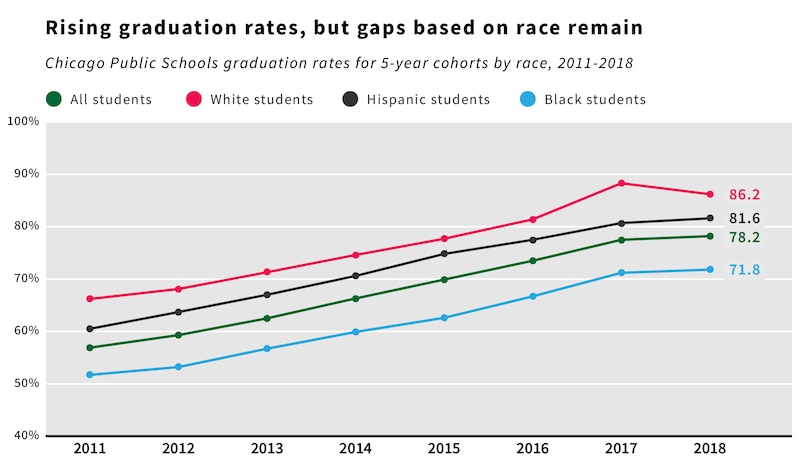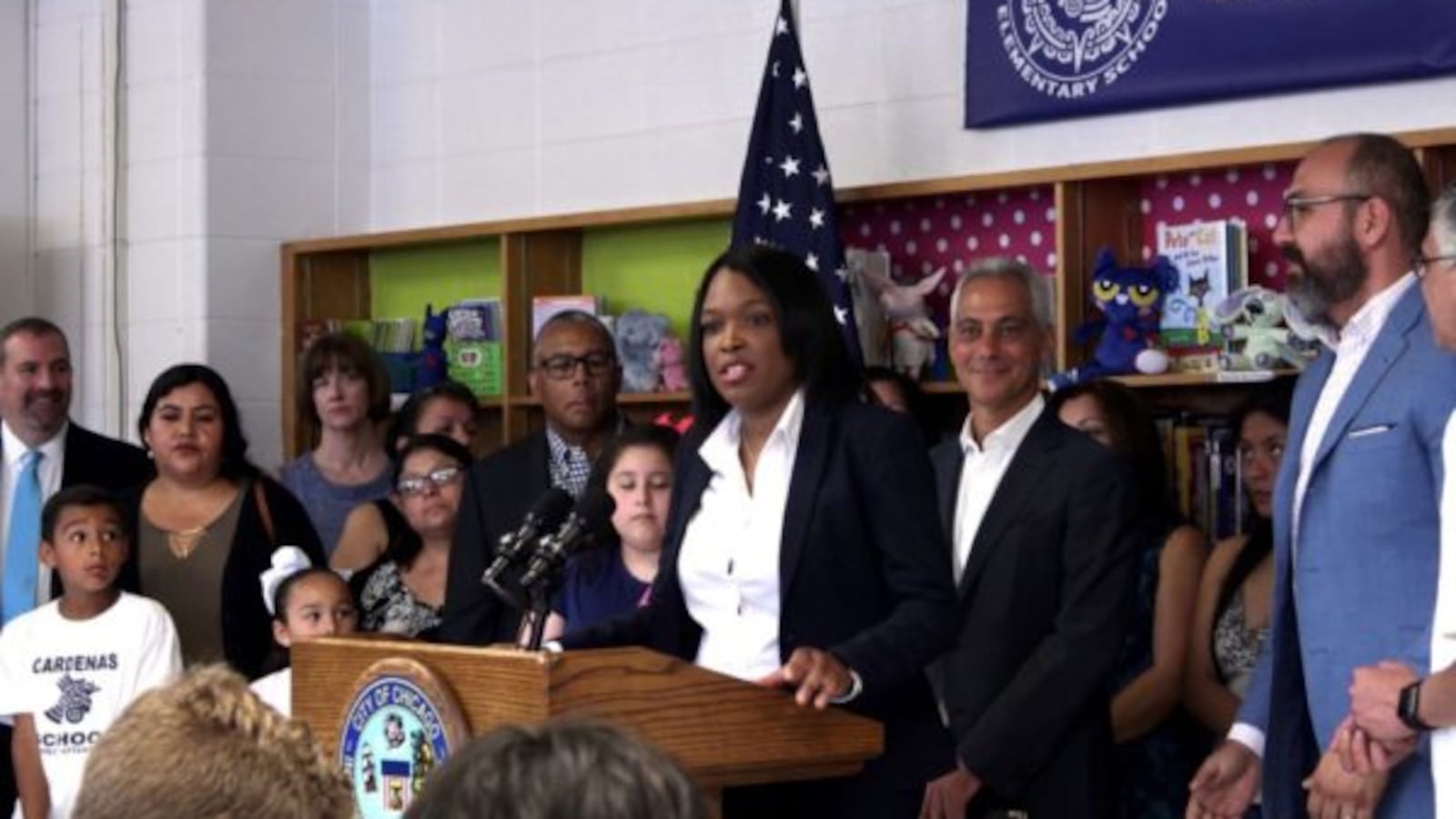Graduation rates at Chicago schools continued to rise this past school year to reach what district officials described as a record high — but gaps separating students by race persist, and the district still significantly trails national averages.
The nation’s third largest district said 78.2 percent of students earned a high school diploma within five years — its preferred graduation rate yardstick — up from 77.5 percent in 2017.
The city’s graduation rate has shot up since Mayor Rahm Emanuel took office in 2011. That year, it stood at 57 percent. The pace of growth has slowed more recently, including this year.
Chicago highlights its five-year graduation rates — that is, the percentage of any given class that graduates within five years of entering high school. The national four-year graduation rate — without the extra year to finish school — was 84 percent for 2015-16, the most recent statistics available. Chicago’s four-year graduation rate was 75.6 percent this year.
Stubborn gaps separating student outcomes based on race remain — a challenge facing schools across the country. Those gaps narrowed in Chicago this year, driven in part by gains by black and Latino males, and a dip in the graduation rate for white students.
In raw numbers, 20,717 students graduated from Chicago high schools this year, a seven-year high. That compares with 18,446 in 2011, the district said. It’s a significant increase despite declining enrollment across Chicago schools.
“Today, three-fourths of students are leaving high school with a diploma,” Janice Jackson, CEO of Chicago Public Schools, said during a conference call Thursday with reporters reviewing the five-year graduation rate data. “We still have work to do to address the achievement gap, but we’re encouraged by the positive results.”
Since taking office, Emanuel has been hyper-focused on lifting graduation rates, setting an ambitious goal of an 85 percent graduation rate by 2019. Jackson, in the media call, said the district believes the 85 percent goal is obtainable.
Under Emanuel’s watch, Chicago Public Schools has expanded alternative crediting programs, or “options” schools, that help students finish their requirements online or at their own pace.
And it has doubled down on an innovative program to head high schoolers in the right direction. The program, incubated at the University of Chicago, assigns points for steady grades and attendance in the early years of high school. Each school has “freshmen on track” indicators that signal which students are at-risk and also which aspects of school might be causing students to drop out.
The district credited that program for helping boost the city’s once-dismal graduation statistics.
Among the notable trends in this year’s graduation data:
- The graduation rate for black males was 64.7 percent, an increase of nearly 2 percentage points. The rate for black students overall grew just slightly more than half a percentage point, a markedly smaller gain than in recent years.
- Latino boys’ graduation rates rose from 75.8 percent to 77.3 percent this year. All Latino students’ graduation rates edged up nearly one percentage point, to 81.6 percent.
- Graduation rates for white students dipped for the first time during the Emanuel administration— from 88.3 percent to 86.2 percent.
- Gaps separating white and black students’ rates declined, from 17 percent last year to 14.4 percent this year. There was a significant narrowing between white and Latino students, with the gap separating the groups falling from 7.6 percent to 4.6 percent.

Jackson acknowledged Chicago Public Schools’ need for improvement and continued support in the graduation rate for black and Latino males, and the need to keep up with the national growth in graduation figures. About 38 percent of Chicago students are African-American, “so that’s definitely an area where I want us to focus because I think we can make a lot of headway pushing on that demographic in particular,” she said.
Jackson, in her first year as CEO, said the district needs to make sure students get access to demanding academic programs, such as Advanced Placement and International Baccalaureate courses, “because the research is clear that if students are engaged in high quality and rigorous coursework that challenges them, they’re more likely to finish school.”
The district has much work ahead to accomplish that goal. An unreleased report by a school choice group, a copy of which Chalkbeat obtained, showed vast disparities in the availability of high-demand programs based on race and geography.
Chicago’s graduation rate gains have come as national rates have risen. Nationally, the high school graduation rate from the 2015-2016 school year — the most current data published by the federal Department of Education — was 84 percent for the four-year adjusted cohort graduation rate.
Chicago’s 75.6 four-year graduation rate was comparable to New York City, the nation’s largest district, which graduated 74.3 percent of its students in four years, according to data from 2017, the most recent available.
After years of marked decline, the Chicago district’s dropout rate largely held steady compared with last year, at a shade below 19 percent, according to district data.
Jackson addressed skepticism of CPS figures, which in the past were revealed as inflated.
“The methodology for CPS has been under scrutiny for a long time, but our data has been cleared and substantiated by the University of Chicago Consortium on School Research and state of Illinois,” Jackson told reporters. “Both of those entities actually publish higher rates than what CPS publishes because we have refined our process to be as conservative as possible.”
Search and compare graduation rates at Chicago high schools by clicking in the box below:
Graphics by Samuel Park

